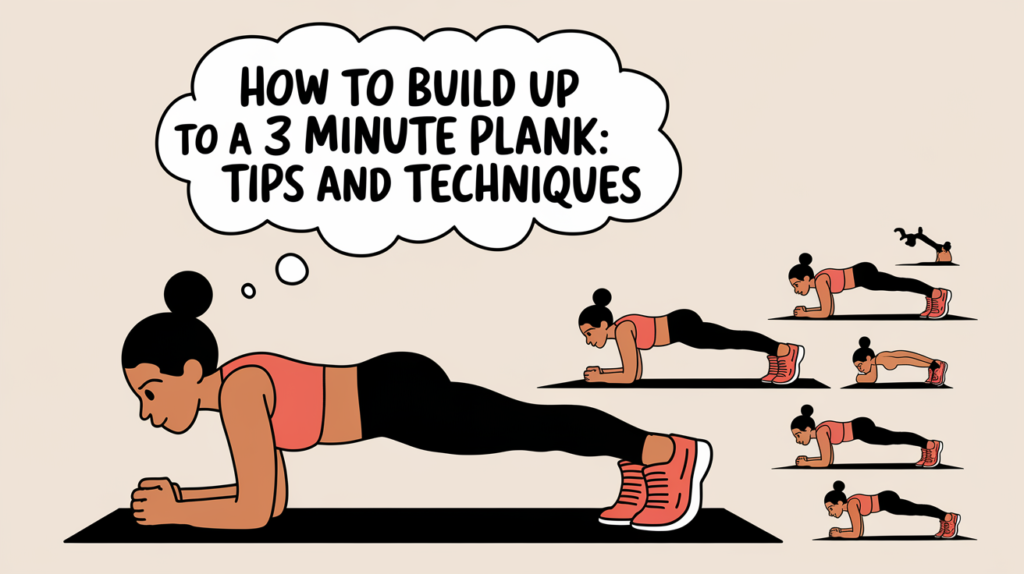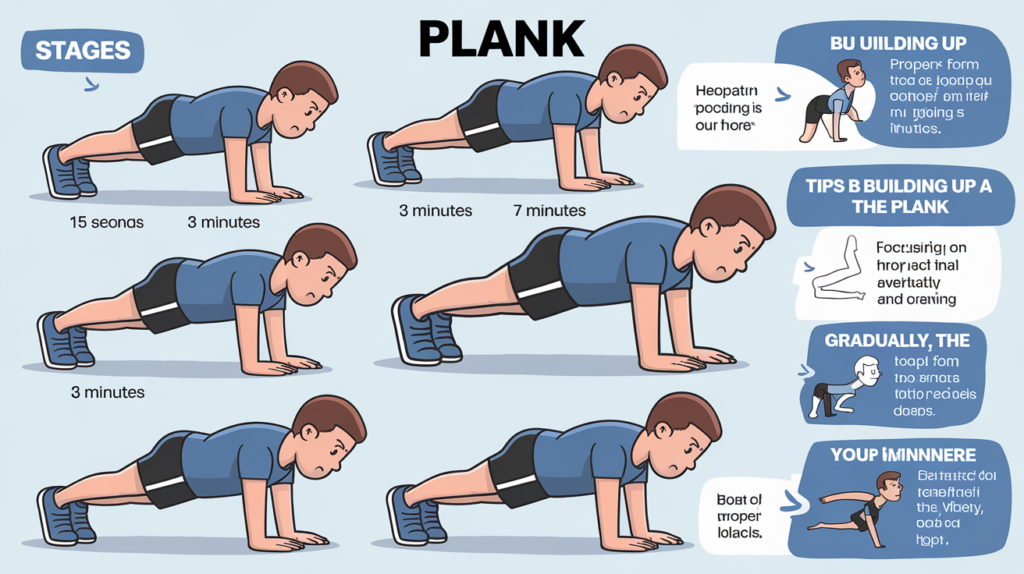Achieving a 3-minute plank is no small feat—it requires a combination of core strength, endurance, and mental resilience. However, with the right training and gradual progression, this goal is within your reach. In this guide, we’ll explore the benefits of holding a 3-minute plank and provide you with tips and techniques to help you build up to this impressive milestone.
Why Aim for a 3-Minute Plank?

Before diving into the how, it’s important to understand the why. Here’s why a 3-minute plank is worth the effort:
1. Enhanced Core Strength
The plank is one of the most effective exercises for strengthening your core, which includes the rectus abdominis, transverse abdominis, obliques, and lower back muscles. A strong core is essential for overall stability, balance, and posture.
2. Improved Endurance
Holding a plank for three minutes requires muscular endurance. As you work toward this goal, you’ll not only improve your core strength but also your ability to sustain physical effort over a longer period, which can benefit your performance in other exercises and activities.
3. Full-Body Engagement
The plank is a full-body exercise. While the core is the primary focus, your shoulders, arms, glutes, and legs are also engaged, making it a comprehensive workout that tones multiple muscle groups.
4. Mental Toughness
Holding a plank for an extended period isn’t just a physical challenge; it’s a mental one as well. The discipline and focus required to maintain the position for three minutes can help build mental resilience, which can translate into other areas of your life.
How to Build Up to a 3-Minute Plank

Reaching a 3-minute plank is a process that requires gradual progression and consistent practice. Here’s a step-by-step guide to help you achieve this goal:
1. Start with Proper Form
Before attempting to increase your plank duration, ensure that your form is correct. Proper form is crucial for maximizing the effectiveness of the exercise and preventing injury.
How to Perform a Proper Plank:
- Start by lying face down on the floor or a mat.
- Place your forearms on the ground with your elbows directly under your shoulders. Your forearms should be parallel, and your palms can be flat or clasped together.
- Lift your body off the ground, forming a straight line from your head to your heels.
- Engage your core by pulling your belly button toward your spine. Keep your hips level, and avoid letting them sag or lift too high.
- Your shoulders should be directly above your elbows, and your neck should remain neutral, with your gaze focused slightly ahead of you.
2. Set a Baseline
Before you start working toward a 3-minute plank, establish your current plank time. Hold a plank for as long as you can with proper form, and note the time. This will give you a baseline to measure your progress.
3. Gradually Increase Your Time
Once you know your baseline, aim to increase your plank time by 10-15 seconds each week. For example, if your current maximum is 30 seconds, aim for 40-45 seconds the following week. This gradual progression allows your muscles to adapt and build strength without risking injury.
4. Incorporate Plank Variations
Adding variations to your plank routine can help you build strength and endurance more effectively. Variations challenge different muscle groups and keep your workouts interesting. Here are a few to try:
- Side Plank: Targets the obliques and improves lateral stability.
- Plank with Leg Lift: Increases the challenge for your core, glutes, and hamstrings.
- Plank to Push-Up: Combines core stability with upper body strength.
- Plank with Shoulder Taps: Introduces movement and challenges your balance and coordination.
5. Practice Consistently
Consistency is key to building up to a 3-minute plank. Aim to practice planking 3-4 times per week, gradually increasing the duration each time. Consistent practice will help you build the necessary strength and endurance over time.
6. Focus on Breathing

Proper breathing is essential for maintaining stability and focus during the plank. Practice deep, controlled breathing throughout the exercise. Inhale through your nose and exhale through your mouth, maintaining a steady rhythm. This will help you stay calm and composed as you work toward the 3-minute mark.
7. Strengthen Supporting Muscles
While the core is the primary focus during the plank, other muscles like your shoulders, arms, and glutes also play a significant role. Incorporate exercises like push-ups, shoulder presses, and glute bridges into your routine to strengthen these supporting muscles, making it easier to hold the plank for longer.
8. Set Milestones
Break your goal into smaller, more manageable milestones. For example, aim to hold a plank for 1 minute, then 1.5 minutes, and so on. Celebrate each milestone as you reach it to stay motivated and track your progress.
9. Use Mental Strategies
Holding a plank for three minutes can be mentally challenging. To help push through the discomfort, use mental strategies such as counting your breaths, visualizing your success, or breaking the time into smaller segments in your mind.
10. Listen to Your Body
While it’s important to challenge yourself, it’s equally important to listen to your body. If you experience pain, especially in your lower back, stop the exercise and reassess your form. Consider taking a rest day if needed to allow your muscles to recover.
Overcoming Common Challenges

As you work toward a 3-minute plank, you may encounter some challenges. Here’s how to overcome them:
1. Fatigue and Muscle Burn
As you hold the plank for longer durations, you may experience fatigue and muscle burn, particularly in your core, shoulders, and legs. To overcome this, focus on your breathing, engage all the muscles in your body, and remind yourself of your goal. If needed, take short breaks and gradually work up to holding the plank for the full duration.
2. Maintaining Proper Form
Maintaining proper form for three minutes can be difficult, especially as you start to fatigue. If you notice your form slipping, take a brief break, reset, and try again. It’s better to hold the plank for a shorter duration with good form than to push through with poor alignment, which can lead to injury.
3. Mental Toughness
Holding a plank for three minutes requires mental resilience. To stay focused, try using visualization techniques, such as imagining yourself achieving your goal or thinking about the benefits you’ll gain from completing the challenge. Breaking the time into smaller segments can also make the task feel more manageable.
Conclusion: Achieving the 3-Minute Plank
Building up to a 3-minute plank is a rewarding challenge that tests your physical and mental limits. By following the tips and techniques outlined in this guide, you can gradually increase your plank time, strengthen your core, and improve your overall fitness. Remember, consistency, proper form, and mental focus are key to success. With dedication and perseverance, you’ll be able to achieve the 3-minute plank and enjoy the many benefits it brings to your health and well-being.






